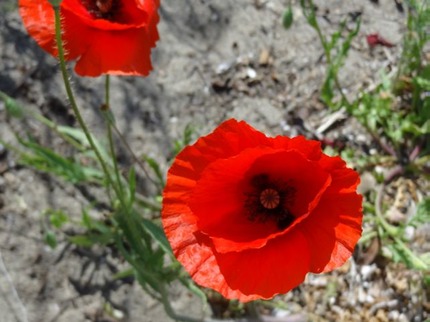7th May - Mum's Birthday
I wasn't sure what to expect heading out to the historical monuments and memorials, the graveyards, cemeteries and gravestones, and the trenches and battlegrounds located throughout the southern tip of the Gallipoli Peninsula. I knew it would have an impact, as it should for every Australian, and as I cam to learn every Turkish, visitor.
This was an area that ultimately proved to be such a critical location of the First World War for so many people, and in some ways signalled the 'start' of two nations - Australia and Turkey.
I had read some of my saved Wikipedia documents about Gallipoli, ANZAC Cove, the Cannakale Martyr's Memorial, Lone Pine to name a few. It was obvious from the bits and pieces I had read and the images I had seen that the battles that took place here were significant for both sides in many ways.
There are great stories of remarkable people, their achievements and courage, the battles they fought and their respect for each other as enemies, the dreadful conditions they fought under and the orders they followed. I hoped to see more of the Gallipoli Peninsula to try and gain a greater appreciation of what had happened and where.
I started my Gallipoli route heading south from Eceabat so that the Dardanelles were on my left, with Anatolian Turkey beyond. Once you see the relationship between the Dardanelles and the Gallipoli Peninsula you gain an understanding of firstly how the early attempts to take Constantinople by ship attacks through the Dardanelles failed and secondly how the attempt to then mount a land attack from the SW parts of the Gallipoli Peninsula were 'ambitious' (to be generous).
The first indication of how long a history there has been of protecting the land and the narrow water is Kilitbahir Castle / Fort built in 1463 by the Ottomans. There is a corresponding fortress on the opposite side of the waterway and they were used to control the straits at their narrowest point. With such a long history and existing infrastructure in place it is no wonder that the campaign using ships failed first.
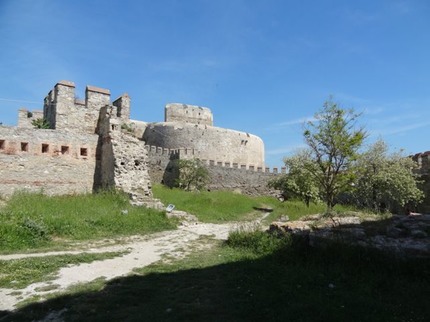
The Castle at Kilitbahir
Shortly after Kilitbahir is a statue that represents the Turkish soldier's determination and efforts throughout the campaign. The statue depicts Corporal Seyit's legendary strength in carrying 255kg shells to the artillery gun after its shell crane was damaged. Again this sets the scene for what was to follow both today and in the past.
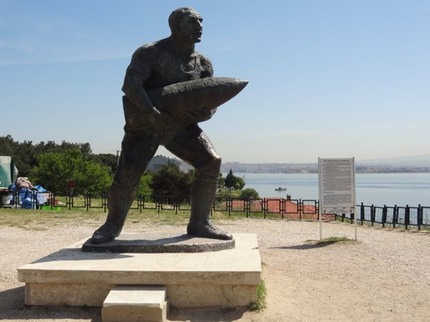
Corporal Seyit's Memorial (Old version) - Soldiers doing impossible things.
As you continue along the road you are never far from another interesting and/or significant site. There were many, many statues, memorials, bunkers and ruins throughout the day.
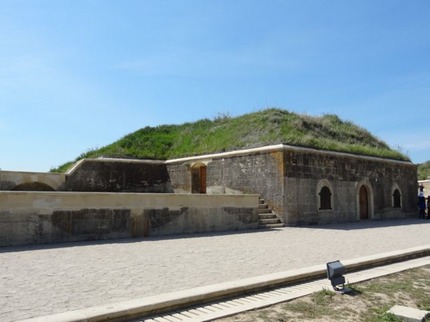
Bunkers near Kilitbahir
After moving on from the area near Kilitbahir I headed further south towards the Canakkale Martyrs' Memorial and Cape Helles. Here I found an amazing stretch of coastal road that was almost completely free of any other traffic after the solemn moments I had experienced already this put a smile on my face and it was probably the best piece of rode I had ridden in Turkey. I decided to attach the GoPro to record for future reminiscing. (You can see the video here.)
After the great stretch of road I stopped off at the first of many cemeteries, all of which have been consistently presented and are very well maintained. It is very easy to get rather emotional when you start to read the gravestones, the names, the ages, and the stones that are inscribed with "Believed to be buried in this cemetery".
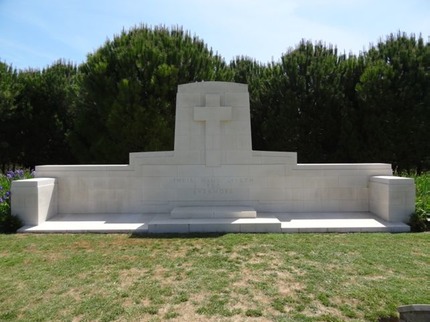
Their Name Liveth For Evermore
Skew Bridge Cemetery
From Skew Bridge Cemetery I made my way to Canakkale Martyrs' Memorial which is an impressive sight. The towering monument sits high above the Dardanelles and has many other statues and memorials to Turkish soldiers nearby which all create a very moving location.
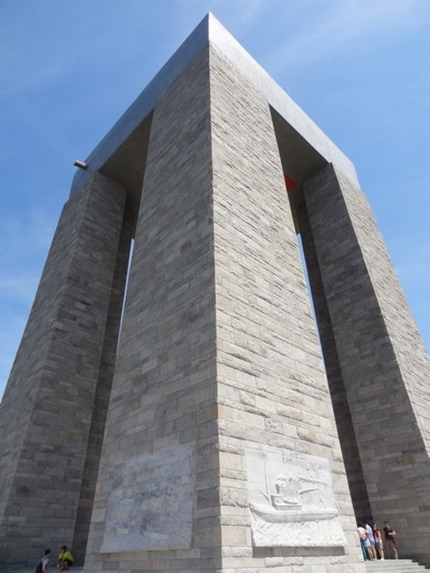
Canakkale Martyrs' Memorial
Although I saw a small amount of the Turkish memorials and gained only a superficial understanding of their motivation and determination it was obvious that there is much importance to Gallipoli from a Turkish perspective.
I continued further south to Cape Helles where, at the same time as the major landing by ANZAC forces was taking place at ANZAC Cove, a major landing took place by predominately British and French forces. This landing attempt was also largely unsuccessful.
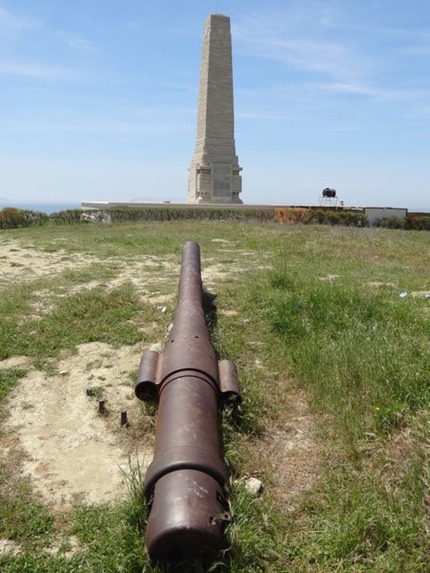
Helles Memorial - Cape Helles
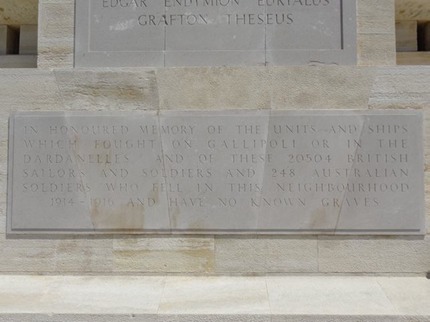
Inscription on Helles Memorial - "AND HAVE NO KNOWN GRAVES"
Following Cape Helles I headed to ANZAC Cove. As I rounded the bend I noticed the small stone wall with the signage indicating ANZAC COVE and recognised the beach from images I had previously seen. I stopped and parked the bike at Ari Burnu which is a small headland separating ANZAC Cove from North Beach.
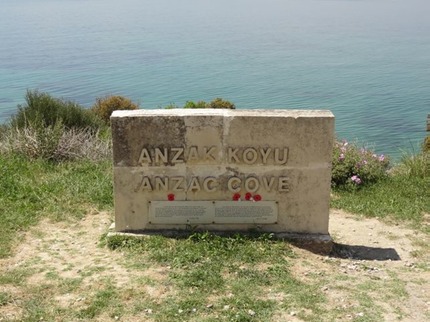
ANZAC Cove
It is here where you can read the words of Ataturk that really start to get the emotions heightened. The words are so clear and meaningful that it is becomes easy to understand why the Turkish people held Kemal Ataturk in such high regard and perhaps also why the soldiers in the battlefields had so much respect for each other.
Next to Ari Burnu is a monolith, on it are the words sent in 1934 by Mustafa Kemal Atatürk, President of Turkey, to an official Australian, New Zealand and British party visiting Anzac Cove:
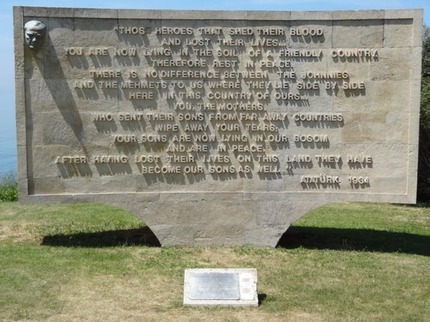
Ataturk's remarkably appropriate words - ANZAC Cove
After reading the words on the monolith I entered the Ari Burnu cemetery.
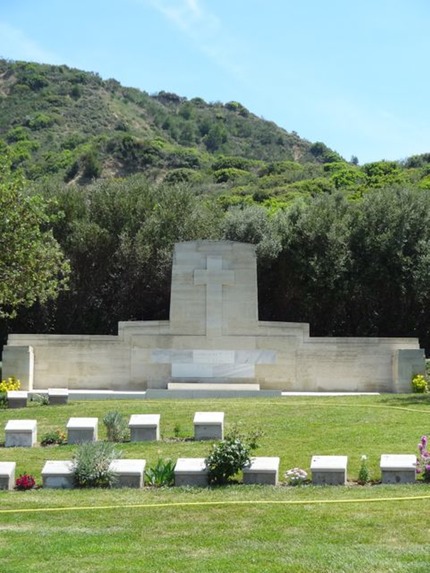
Ari Burnu Cemetery.
It didn't take long before I found the following that truly reinforces all that you might think about what is wrong with war.
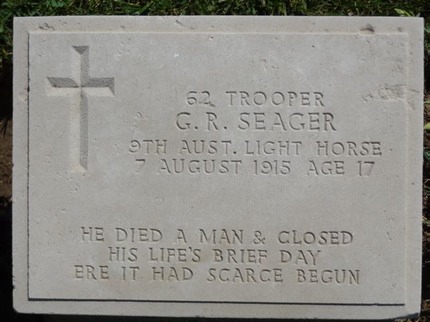
17 Years Old
It is hard not be moved by what you see.
I walked along North Beach to the ANZAC Commemorative Site and noticed some of the remnants from the recent ANZAC Day Service on the shore.
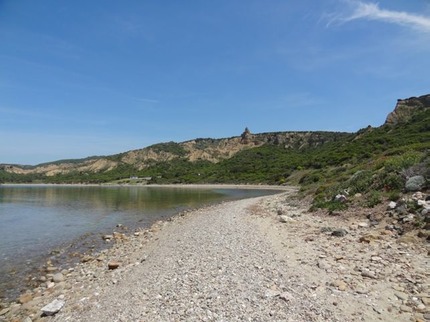
Ari Burnu along North Beach towards the ANZAC Commemorative Site.

A wreath from ANZAC Day on the beach.
At the ANZAC Commemorative Site there were many others also stopped. Here on the wall are several information boards giving a brief outline of the landing, the battles, the conditions and the relationship between the enemies. The following gives an indication of the respect each had for the other:
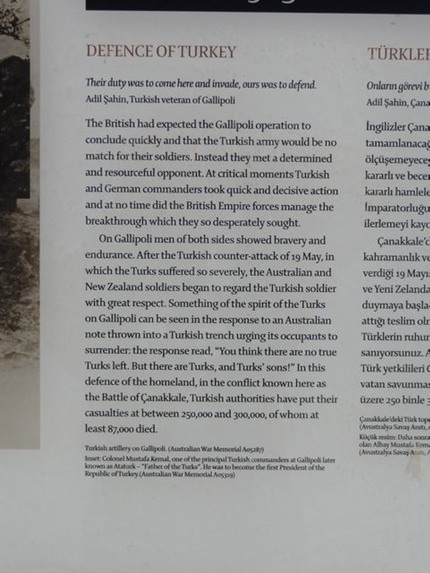
Each respected the other during battle.
Such was the situation on the battlefield that the opposing sides mutually agreed, after several days of heavy fighting in dreadfully hot conditions, to cease fire to allow each side to remove and bury their dead. Afterwards they continued the battle.
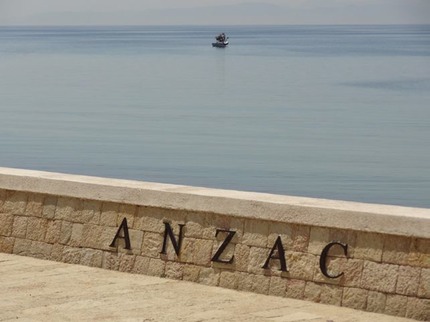
ANZAC Commemorative Site
On a slightly lighter note, one of the surprising stories of ANZAC Cove is that it was a popular swimming spot. The ANZACS would swim in the water in part to relax, although mostly to get cleaned up, despite being shot at by snipers/artillery. For example:
Sergeant Cyril Lawrence, 2nd Field Company, Australian Engineers, went swimming in the cove on the evening of 10 June 1915 when ‘Beachy Bill’ opened up:
There were hundreds on the beach and one of the shells burst over a latrine up on the hillside. The men sit on this, which is just a beam supported at each end over a long hole, like a lot of sparrows on a perch. There is nothing to hide them from the view and they look extremely funny to see all their bare bums in a row … one burst over this latrine. In the scatter that followed, none waited to even pull their trousers up. The roar of laughter that went up could have been heard for miles. It’s only these little humorous happenings that keep things going here.
[The Gallipoli Diary of Sergeant Lawrence of the Australian Engineers, Sir Ronald East (ed), Melbourne 1983, pp 27–8]
http://www.anzacsite.gov.au/2visiting/walk_03anzaccove.html
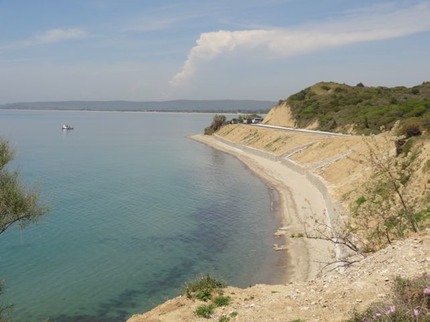
ANZAC Cove
I moved on and stopped at the southern end of ANZAC Cove. I had misunderstood direction to John Simpson gravestone and ended up at the cemetery in Shrapnel Valley instead. Although there was a Simpson buried here it was not the one we had heard the stories about. In the cemetery in Shrapnel Valley I saw my first gravestone dated 25th April 1915. There were not as many with that date as I expected.
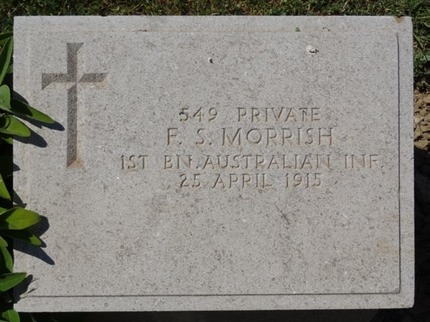
The ANZAC Landing Day - Shrapnel Valley
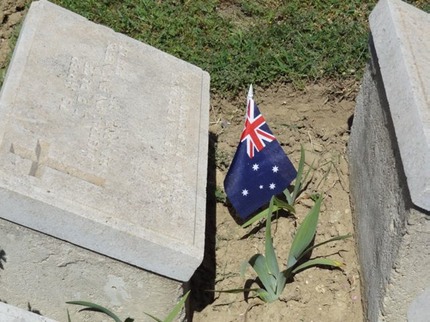
Reminders from ANZAC Day perhaps - Shrapnel Valley.
From Shrapnel Valley I saw a small sign for Lone Pine, and since I hadn't seen any others I followed it. I took the narrow and steep dirt road up the hillside to the back of the Lone Parking area. It was obvious when I saw the buses parked and the smooth bitumen road beyond that I had taken a shortcut.
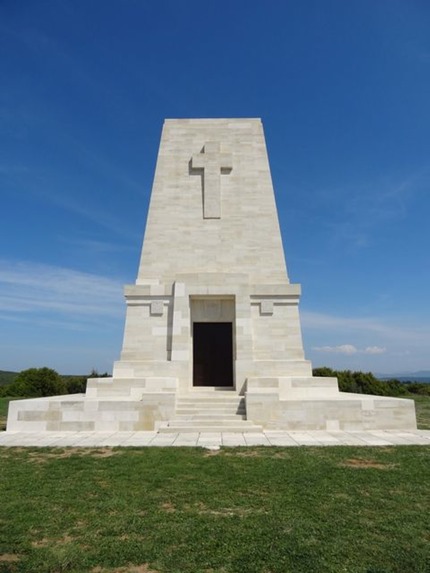
Lone Pine
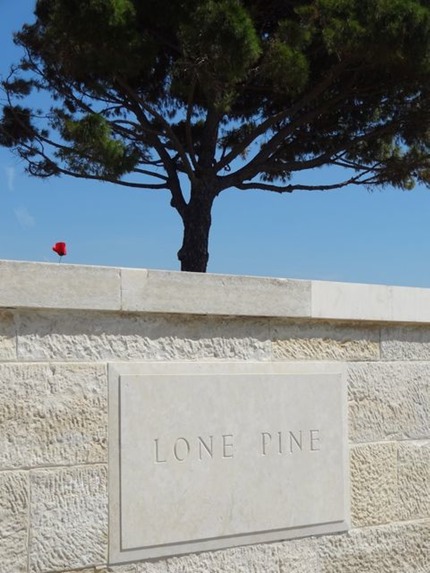
Lone Pine
There were many busloads of people completing their visit to Lone Pine and I was also moving on since I planned to come back again tomorrow. I asked for clearer directions to John Simpson's gravestone and was advised going back down the dirt road again because it was so close that way. I headed downhill and back onto the bitumen road at the bottom and missed the turn-off……..again. I backtracked and found it and took a quick photo.
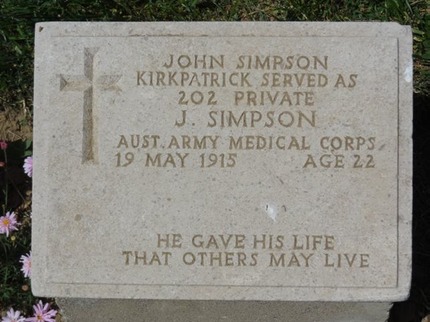
John Simpson - 3weeks and a donkey.
I'd had a pretty good, although emotional day, seeing the major Turkish and ANZAC sites. I had been on and off the bike many times and I was ready for the ride back to The Gallipoli Houses. I had put Suvla Bay in the GPS because it showed up as a salt lake on Google Earth and was also the northern most point of fighting. The road out was clear of traffic and soon became another enjoyable ride through the fields to the sea at the end.
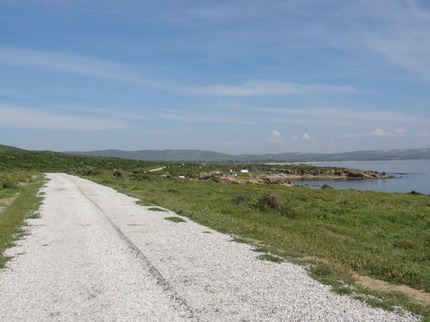
Suvla Bay
I headed back to The Gallipoli Houses and was ready to take it easy with the wonderful cooking, accompanied by red wine before getting to bed reasonably early.
It was a tiring day with some very emotional moments throughout. Being there by myself and silently seeing and experiencing so many of the elements that make Gallipoli such a significant place have had a lasting impact. If ever you get a chance to visit Gallipoli I strongly recommend it.
